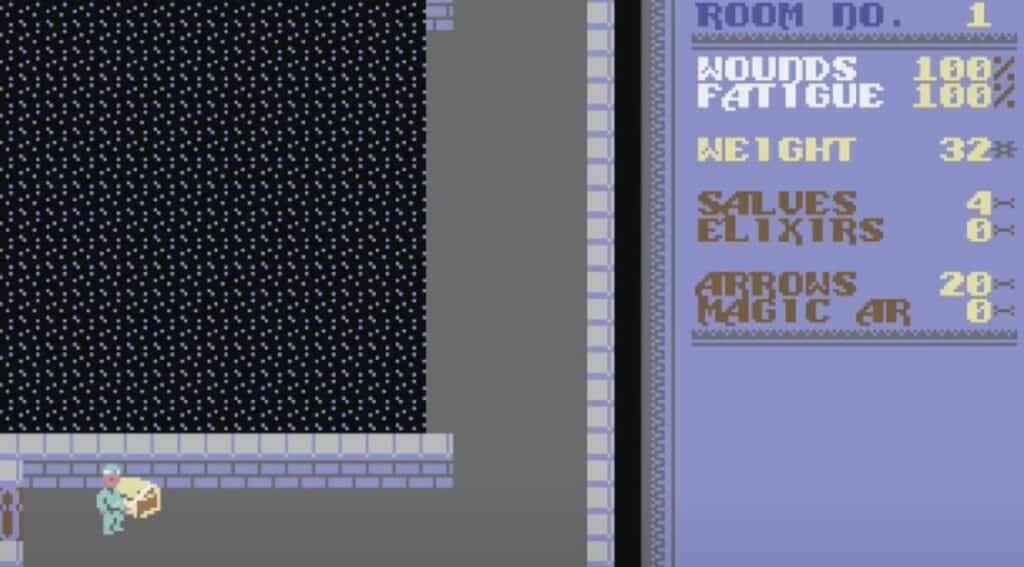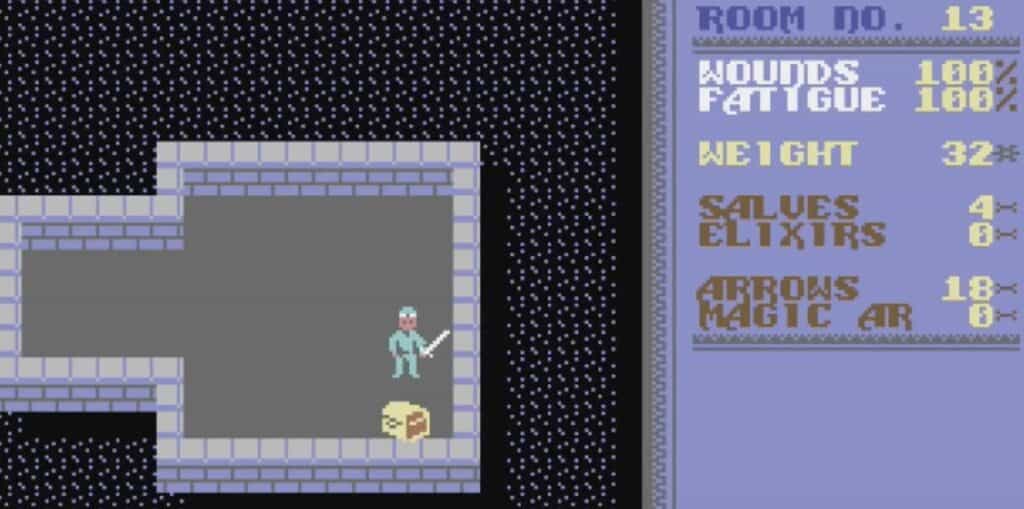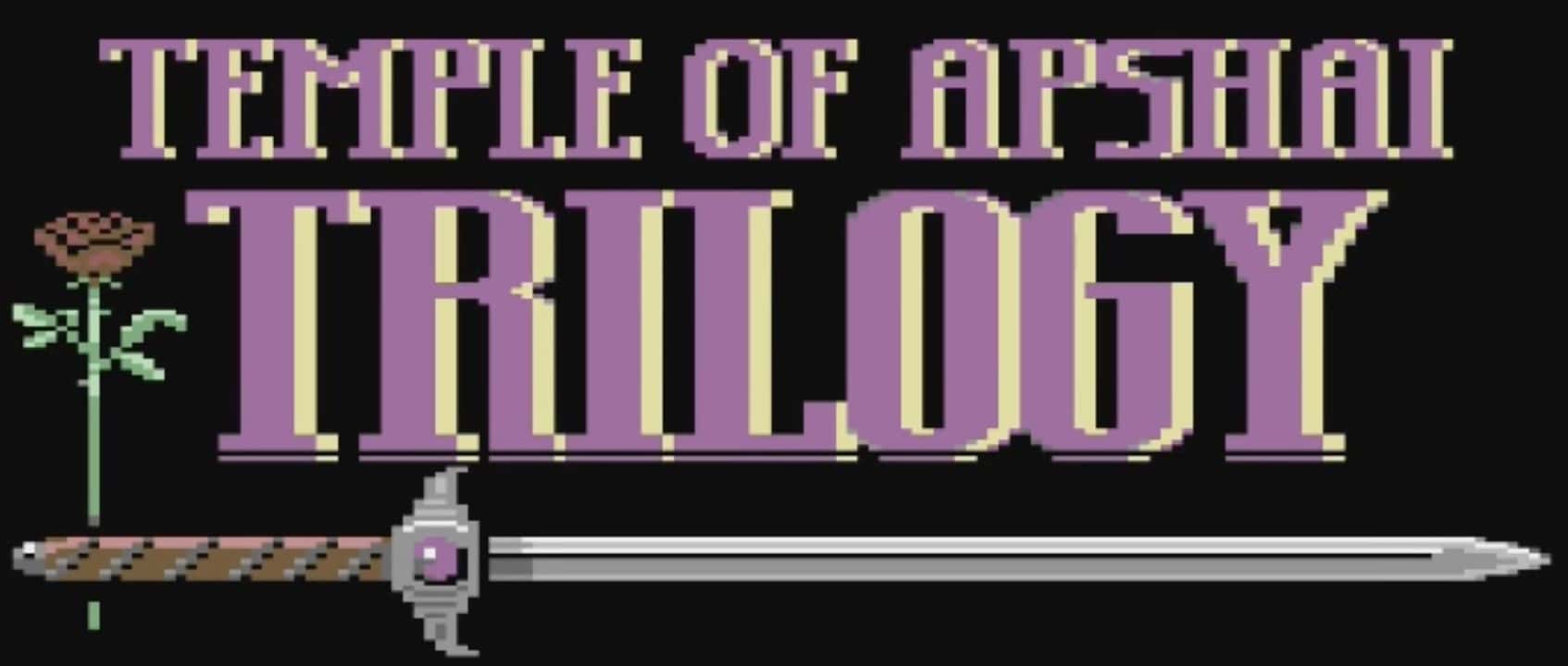Temple of Apshai (also known as Dunjonquest: Temple of Apshai) is a 1979 dungeon crawl role-playing video game. Automated Simulations developed and published Temple of Apshai for TRS-80 and Commodore PET. In 1983, four years after the game’s initial launch, Automated Simulations renamed its company to Epyx to match one of its most iconic gaming series. After Temple of Apshai‘s release, it received many re-releases for other consoles and computers from 1980 – 1986. These other consoles include the IBM PC, Atari 8-Bit, Commodore 64, and Macintosh.
This retro dungeon crawler is a huge staple in the gaming world because it’s considered to be one of the first graphical role-playing games for home computers. Temple of Apshai predates Akalabeth: World of Doom, one of the most well-known early examples of a role-playing video game. At the time of Temple of Apshai’s release, it was a massive success and went on to be a best-seller for four consecutive years. In 1985, the Temple of Apshai Trilogy came out, which included the original game and two expansions. Today, the trilogy is the easiest way to experience Temple of Apshai. PC players can get the Temple of Apshai on Steam for $3.99. The success of the original dungeon crawler spawned several sequels in addition to the two expansions. This series became known as Dunjonquest.
In addition to Steam, players can find Temple of Apshai on different platforms. Gamers can download the game through My Abandonware. My Abandonware is a great resource for classic games. It has a large gaming library that includes games like Starquake and The Rocky Horror Show video game. Lemon64 also has the Temple of Apshai Trilogy available for download.
The reception to this game is somewhat mixed. In 1980, Temple of Apshai won the Origins Award for “Best Computer Game of 1980”. It received high praise for its graphics and groundbreaking home gaming experience. Thanks to its new and innovative way of play, Temple of Apshai sold record numbers for the time. Modern gamers are a bit more mixed about the game. Steam rates Temple of Apshai an okay 6 out of 10 but My Abandonware rates it a 4.1 out of 5. According to Google, 98% of people who weighed in on the game claimed to like it though, meaning its legacy stands the tests of time.
Temple of Apshai Premise
As expected of a dungeon crawler, the player has to explore the ruins of the Temple of Apshai. The player controls an adventurer who has to make their way through the temple, fighting enemies, and collecting treasure. The gameplay focuses on the explorer moving from room to room, investigating each for signs of anything interesting or useful. While exploring, the player will encounter armor and weapons that will equip them with the necessary strength to challenge the lurking monsters. Temple of Apshai features four different temples to explore. All the temples have over 200 rooms combined. The game also features 30 unique monsters to fight and conquer. In 1979, this sort of home gameplay was practically unheard of.
Unlike other games of the 1980s and ’90s, Temple of Apshai did feature a way to save… sort of. Although the original release had no save function, players could write down their stats before quitting the game. When they next decide to play, before getting into the actual game, they could re-input all of their stats to resume their previous game. Future re-releases of the game actually solved this problem by implementing a save feature into the game. This was an extremely impressive feature in general since most games of the time operated on a Game Over system. Once players received a Game Over, they would need to start all over again.
The game is loosely based on Dungeons & Dragons (D&D), the popular tabletop role-playing game. Today, RPGs still take inspiration from D&D. Some video games like Baldur’s Gate 3 and Neverwinter are legitimate D&D games. Other RPGs like Elden Ring and The Elder Scrolls also take inspiration from D&D, especially where character classes and combat are concerned. Temple of Apshai took six base stats straight out of Dungeons & Dragons. It also uses D&D combat mechanics, like character stats determining what sort of equipment they can carry and use.
Temple of Apshai combines turn-based combat with real-time combat. Players can use their turns for several actions, including advancing nine steps, attacking, or even trying to talk an enemy out of fighting. Everything the player does will slowly cause fatigue. Once the player’s fatigue meter hits zero, they’ll be forced to rest before they can continue on their journey. In all these ways, the game mirrors Dungeons & Dragons, which is also a turn-based combat game where the player has many options to do whatever they want. The longer the player explores, the more XP they’ll gain to level up their character.
It’s also worth noting that the game was the first role-playing computer game to utilize written room descriptions. This forces players to compare on-screen rooms with descriptions in the game manual to figure out where they are. This mimics the way a D&D party’s Dungeon Master would describe the setting in verbal or written words to help set the scene for the players. If the player dies, a non-player character (NPC) can revive them too.
Temple of Apshai Main Characters

©Emceemur / Automated Simulations / Epyx – License
Although Temple of Apshai took a lot of inspiration from Dungeons & Dragons, the video game is, at heart, a dungeon crawl role-play game that focuses on the gameplay. The mechanics are intricate and, for the time, very advanced, but there isn’t an overarching story or end goal. Players can explore, challenge enemies, and collect loot. Since there isn’t much of a plot, there isn’t a lot of emphasis on the characters either. This is the one portion of the game that differs drastically from D&D. D&D is all about creating fun and unique characters that players get to insert into a larger campaign story. Temple of Apshai doesn’t put as much emphasis on the characters, but there are a couple worth mentioning.
The Adventurer
The Adventurer is the main playable character and protagonist of Temple of Apshai. The game never names the Adventurer because this character is supposed to mimic the Dungeons & Dragons mechanic of the player creating a character for the game. The Adventurer’s only real goal is to explore the Temple of Apshai, fight monsters, and collect loot. Other than these fundamental dungeon-crawler mechanics, the Adventurer has no real purpose or backstory.
The Temple of Apshai game manual does provide a written description of the player’s character. The description is vague enough that the player can imprint anyone they want onto the Adventurer. The description reads:
You are a lone adventurer, strong of sinew and keen of blade and mind. Your senses must be sharp as the talons of an eagle, to warn you of swift dangers. You must be strong. Only the stoutest of constitutions will stand against the rigors of the journey that lies ahead. Yet, you must be subtle. Only a deep mind can fathom the mysteries to be unfolded. Sometimes, when strength falters, only sleight of hand will save you. Yet all will not be darkness. At times your quick wit with a wandering monster or cleverness in parlay with the Innkeeper will greatly advance your course. Such is intelligence. Logic will also be indispensable to you. In the end, when all visible resources are depleted, you will fall back upon ego - the well of the self which is man's last reserve. I could tell you tales of horror and madness, but this would not serve. The Trilogy of Apshai, like truth and beauty, cannot be told. You must experience to know. The ear is to listen, the heart is to feel, the soul is to know. These three are the simple truths of Apshai.
The Innkeeper
The Innkeeper is mentioned in the Adventurer’s introduction. This NPC is an alley that provides the player with equipment, advice, and other aid. The Innkeeper is at the beginning of the game and will help the player “select” a character to play. From there, the player can purchase weapons and armor from the Innkeeper. Players can also haggle with the Innkeeper to try and get better deals on their “adventurewares”. The Innkeeper also has salves to treat wounds and help the MC heal. When players find treasures within the temple, they can take them to the Innkeeper for evaluation.
Temple of Apshai Titles in the Series
Temple of Apshai was a huge success and a trailblazer game for the at-home RPG genre. Since the game turned out to be a best-seller for several years, it received two expansions. It also inspired several sequels that were known as the Dunjonquest series.
The Dunjonquest Series:
- Temple of Apshai (August 1979)
- The Datestones of Ryn (November 1979)
- Morloc’s Tower (January 1980)
- Hellfire Warrior (September 1980)
- Upper Reaches of Apshai (September 1981)
- The Key of Acheron (September 1981)
- Sorcerer of Siva (December 1981)
- Curse of Ra (1982)
- Danger in Drindisti (1982)
- Gateway to Apshai (1983)
- Temple of Apshai Trilogy (1985) – This trilogy includes the original Temple of Apshai, Upper Reaches of Apshai, and Curse of Ra.
- Cliffs of Tyyr (unreleased)
Other Related Games:
- The Starquest Series – A series of two games that mimicked Temple of Apshai but used a science-fiction setting and theme instead. It was short-lived because it was nowhere near as popular as the Dunjonquest series.
- Rescue at Rigel (1980)
- Star Warrior (1980)
- Crush, Crumble and Chomp! (1981) – The developers used the Dunjonquest engine to build Crush, Crumble and Chomp!
Temple of Apshai Cheats, Passwords, & Commands

©Emceemur / Automated Simulations / Epyx – License
Throughout the 1980s and ’90s, many video game developers built cheats into their games on purpose to make them easier to complete. This would keep the integrity of the game’s challenge in place for those who wanted to play it authentically. For gamers who knew about the cheats, passwords, or exploits, their gaming experience would be much smoother. Game developers likely did this because most games couldn’t be saved.
Temple of Apshai is a little bit different because, technically speaking, players could pick up where they left off. This forced them to write down all of their stats so they could re-enter them when they decided to play again, but they could theoretically pick up where they left off. Eventually, the developers of Temple of Apshai released a version that could be saved. Since Temple of Apshai was one of the first RPGs gamers could play at home, it didn’t necessarily follow the video game trends of the time. It was opening new doors and making way for future games.
To play Temple of Apshai effectively, players will need the Temple of Apshai Trilogy – Manual. Unfortunately, the game doesn’t feature many cheats, cheat codes, or exploits, though. There is an Unlimited Lives cheat, but it requires the player to use a BASIC command.
Unlimited Lives Cheat
- Load and/or reset the game
- Execute the following BASIC command: POKE 3574,44
- Restart the game
- This should reward the player with Unlimited Lives in-game
Temple of Apshai Command Sheet
Movement Commands:
- 0 – Rest for one turn
- 1-9 – Move from 1 to 9 feet
- R – Turn 90 degrees to the right
- L – Volte-face (Turn around 180 degrees)
- SPACE – For each press, move forward 1 foot
Battle Commands:
- A – Attack
- T – Thrust
- P – Parry (Defense)
- F – Fire an arrow
- M – Fire a magic arrow
Special Commands:
- E – Examine a wall for a secret door
- O – Open door
- S – Search for traps
- G – Get or pick up treasures
- Q – Query (listen) for monsters
- ! – Speak with a monster
- H – Heal (Apply a healing salve)
- Y – Ylixer (Drink a healing elixir)
- D – Drop a treasure
- <C/R> – Room description
Temple of Apshai Cheats FAQ
If gamers Google “Temple of Apshai Cheats”, no FAQ results pop up. Searching “Temple of Apshai” also has no frequently asked questions.
The image featured at the top of this post is ©Emceemur / Automated Simulations / Epyx.
